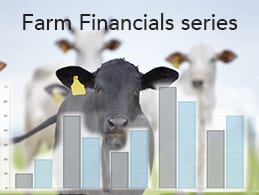Help is available in times of disaster
 The past few weeks have been truly heartbreaking and a test of industry survival for many primary producers.
The past few weeks have been truly heartbreaking and a test of industry survival for many primary producers.
Many have gone from years of drought ravaged pastures and stock to losing entire herds in a week due to unprecedented flooding.
We have just witnessed, and are dealing with, the worst cattle losses in Australian history.
Previous articles have looked at using tax incentives such as forced sales or farm management deposits to smooth out the highs and lows of income that can occur in the primary production industry.
With an unprecedented disaster such as this, the focus must switch to recovery.
Though tax will always be an underlying driver in any business for these producers, the primary focus from a financial perspective will be in the clean-up, repairing of infrastructure and replenishing stock numbers.
Where stock has been significantly depleted or wiped out completely, generating a cash flow is not viable, or realistic.
The immediate assistance required here is a direct injection of cash to help producers manage this. So what help is available to assist with the challenges that lie ahead?
There are grants and low-interest loans available to those affected by this disaster.
Each of these tools will assist in raising the necessary cash required to help these businesses in this time of recovery and rebuilding.
It is worth noting here that the assistance available is still changing and being adapted to suit those affected.
This can already be seen with the primary producer grant being increased from a maximum of $25k to $75k.
What is stated in this article has been researched on the current grants and loans as they stand; however please note, these may be subject to further changes.
Grants
Special Disaster Assistance Recovery Grants (currently $75k) – Primary Producer
The Special Disaster Assistance Recovery Grant is offered exclusively to primary producers by the Queensland Rural and Industry Development Authority (QRIDA).
The grant is for a maximum amount of $75k and you have to be in one of the defined disaster areas to be eligible.
The main supporting information required to receive the grant is photographs of the direct damage i.e. stock losses and damaged fences. Additional quotes and estimates are recommended, but not required.
The relatively low-level requirements with this grant should provide some much-needed relief for producers, easing the burden of proof that’s applicable with other grants (such as the small business grant, discussed further on).
This grant was established to help with costs associated in clean up and reinstatement activities such as hiring or leasing equipment, repairing or replacing fencing and replacing livestock.
A common question in connection to this grant is: What if within a group there was more than one property affected? Is the grant available more than once?
At this point there isn’t a standard answer. The QRIDA stated it would assess on a case by case basis.
If it can be proved that the properties were operating independently from one another, then the grant will be available for each effected property.
QRIDA will consider factors such as staffing arrangements, whether each property had its own plant and equipment and stock. Also, whether the properties have different accounting arrangements and if the properties trade independently of each other.
All factors will be assessed to determine whether the grant can apply to each individual property.
From a tax perspective, government grants are generally considered assessable income.
This would mean the $75k would need to be declared in the tax return of the recipient entity.
There are a few things to consider with respect to this. Firstly, given the significant stock losses and expected expenditure on immediately deductable items such as fencing, it is unlikely that this grant would be enough to cause there to be a tax bill to pay in the current financial year.
More likely this will decrease the amount of tax losses carried forward. This means that if these primary producers start making profits again in future years, there will be less losses to offset that income.
This issue was prominent in the 2011 financial year when North Queensland suffered significant damage from Cyclone Yasi.
To mitigate this issue for those that received the grant back then, specific legislation was passed to exempt those grants from being assessable.
So, there is the possibility that the same could be done with this natural disaster but that is yet to be determined.
Special Disaster Assistance Recovery Grants (currently $25k) – Small Business
The Special Disaster Assistance Recovery Grant is available for all small businesses affected by the natural disaster, which is inclusive of primary producers and is available in conjunction with the $75K primary producer grant. Again, it is offered by QRIDA.
There are however, more requirements for the small business grant.
Firstly, you have to be in one of the defined disaster areas, which are not as extensive as the primary producer grant disaster areas.
It means some primary producers may be eligible for the primary producer grant and not the small business grant, depending on where they are situated.
The small business grant is split into two amounts.
The first $5k is initially available and the proof required for this amount is evidence of damages and quotes on repairs.
The second $20k is available after the fact, that is, the proof needs to be evidence of damage, invoices and proof of payment. The business must first outlay the money and then be reimbursed.
GST also has an impact on the amount that can be claimed with this grant.
If the small business entity making the claim is registered for GST, it still claims the GST portion of the invoices on the BAS, and the grant will reimburse the non-GST component.
This essentially means a total of $27.5k in invoices can be claimed under this grant, as $2.5k of that will be claimed as GST on the BAS and $25k will be reimbursed as the non-GST portion of those invoices.
Freight Recovery Grant (currently $5k) – Primary Producer
This grant which is offered by the Department of Agriculture and Fisheries is similar to the small business grant above as it is offered as a reimbursement after the expense has been paid as opposed to a forward payment.
This grant is specific to freight and allows for reimbursements up to $5k. The freight can be for a range of purposes such as fodder, equipment, transport, the removal of stock or restocking.
Low Interest Loans
Disaster Assistance Loans (currently $250k each) – Primary Producer
This loan is available to primary producers within the defined disaster area up to an amount of $250k, over a term of 10 years and with an interest rate of 1.37%. The loan offers two years of interest-only if required and does not have any establishment fees, nor any account maintenance fees and fees for early payout.
Disaster Assistance Loans (currently $250k each) – Small Business
This loan is available to any small business affected and the loan characteristics are identical to that of the primary producer loan discussed above.
The only difference between the two loans are the defined disaster areas. The small business loan has a more defined list of shire councils in which the loan is offered, similar to the grants.
Disaster Assistance Essential Working Capital Loans (Currently $100k) – Primary Producer
Similar to the $250k loan available to primary producers, this loan has the same characteristics of a 1.37% interest rate, 10-year term and no fees. The differing factor is the intended purpose of the loan.
Where the $250k loan is designed to assist in the repairs and replacing infrastructure, this working capital loan is additionally provided to assist in paying immediate bills such as salaries and wages, rates and purchasing fodder.
Through the use of both the grants and low interest loans, there is a total potential of $705k in cash funding per primary producer available. $105k in grants and $600k in low interest loans.
This funding will help primary producers that qualify to raise some of the much-needed cash to aid in the recovery process, though for many, it will only cover a small portion of the damage bill sustained in this devastating natural disaster.
About the Author:

Clancy Cox is a fourth-generation cattle farmer from the Cox and Atkinson lineages. His great-grandfather Monty Atkinson was instrumental in developing the droughtmaster herd which is still incorporated in the family operation today. Clancy was born and raised on “Glensfield Station,” a cattle station 45km west of Mackay. The family operation runs 10,000 head of cattle for breeding and fattening across three properties.
Clancy has a unique understanding of the agribusiness sector, combining his involvement in the family operation with skills he has developed as a Senior Accountant at PVW Partners.
Clancy is passionate about growing regional Australia.
Disclaimer
Information provided in the article is of a general nature and is intended for informative purposes only. It does not take into account personal financial circumstances. Tailored professional advice should be sought before acting on any of the information contained above.
Links to the relevant grants
Special Disaster Assistance Recovery Grants (currently $75K) – Primary Producer:
Special Disaster Assistance Recovery Grants (currently $25K) – Small Business:
Freight Recovery Grant (currently $5k) – Primary Producer
Disaster Assistance Loans (currently $250k each) – Primary Producer
http://www.qrida.qld.gov.au/entity/primary-producer/natural-disaster-assistance-primary-producer
Disaster Assistance Loans (currently $250k each) – Small Business
http://www.qrida.qld.gov.au/entity/small-business/disaster-assistance-small-business
Disaster Assistance Essential Working Capital Loans (Currently $100k) – Primary Producer
http://www.qrida.qld.gov.au/entity/primary-producer/essential-working-capital-primary-producer

